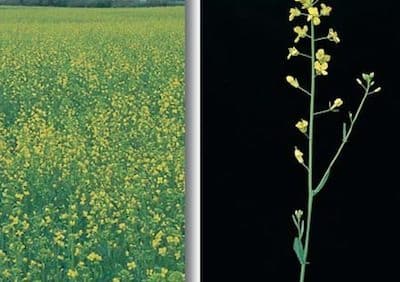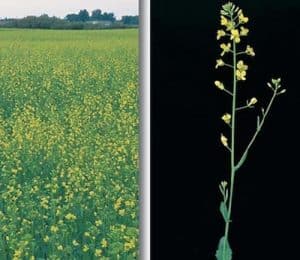The spray window for sclerotinia stem rot is 20-50 per cent flower and for cabbage seedpod weevil is 10-20 per cent flower. The best resource for flower staging is in the Canola Encyclopedia. (Look at Stage 6.)
To assess flowering stage, count all “flowers” — which includes open flowers, aborted flowers and developing pods — on the main stem. Plant population is not a major factor in staging, but because stands with fewer plants per square foot (say five or fewer) can have more flowers on the main stem, you could bump up the counts by a couple of flowers to estimate the flower stage for reduced plant stands.
Count main stem flowers at a few sites in the field and take an average to come up with flowering stage for the field. For example, if you check 10 random plants and three or four are at 30 per cent flower and some are at zero percent, the average is probably around 15 per cent.
At 10 per cent flower, the main stem will have around 10 open flowers. It takes two to four days to go from first flower to 10 per cent bloom.
At 20 per cent flower, the main stem will have 14 to 16 open flowers. Canola can reach 20 per cent bloom within four to five days after first flower.
At 30 per cent flower, petal drop will be happening. If those petals are infested with sclerotinia spores, infection can start within a day. This stage will be reached six to 10 days after first flower.
At 50 per cent flower, the crop is at its “most yellow.” Main stems will have 20+ flowers AND developing pods on the main stem, and side branches are starting to flower. This stage can last a week or more in crops with lower plant counts that result in higher numbers of secondary branching. If track growing degree days (GDD), it takes about 300 GDD to go from first flower to 50 per cent flower.
This video will help you visualize the stages.
Kelly Turkington, plant pathologist with Agriculture and Agri-Food Canada, provides the following guidelines and reminders on fungicide timing:
- “I don’t get too hung up on specific flowering stages at least in the sense of small differences. I look at broad stages. At 20 per cent flower, which is before petals start to drop, you protect the petals and the canopy from the earliest infections that tend to cause the most yield loss.”
- At 50 per cent flower, the field is at its most yellow. A field with fewer plants and a lot of branches may be at its most yellow for a week or more, but again, if conditions are right for disease, protecting the plant from those earlier infections will provide the greater return on investment for the fungicide.
- Fungicide applied at the beginning of the label window will coat the petals that are there, but also provide important coverage down in the canopy. Fungicide down in the canopy coats the key plant tissues where the most damaging infections occur. These targets include leaves, leaf bases, leaf axils and perhaps even leaf petioles where infested petals clump. That is why water rates are so important – to get that penetration and coverage into the canopy targets. Fungicide protection in these areas can last two weeks or more. That is why fungicide targeting is not just about the petals because flowers only have about a six-day life cycle. If you were to focus on applying fungicide on petals themselves, you would need to repeatedly apply fungicide to coat each successive crop of newly emerged flower and petals.
- As for early applications that target buds before they open to form flowers, that is probably not providing much benefit given the limited systemic action of the fungicides available for canola. They would not typically penetrate from the green sepal tissue into the petal tissue itself.

